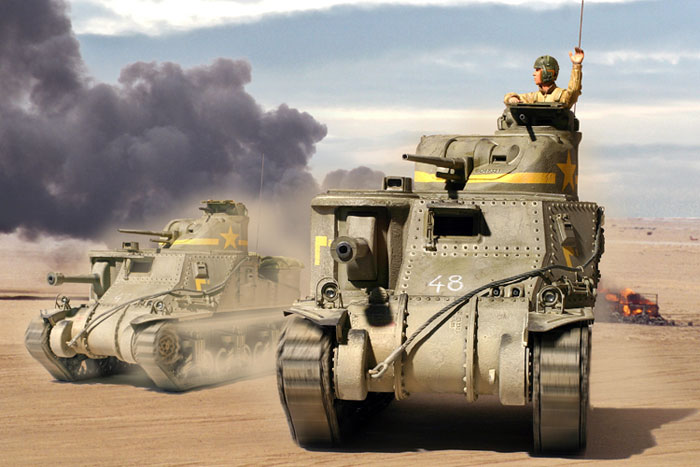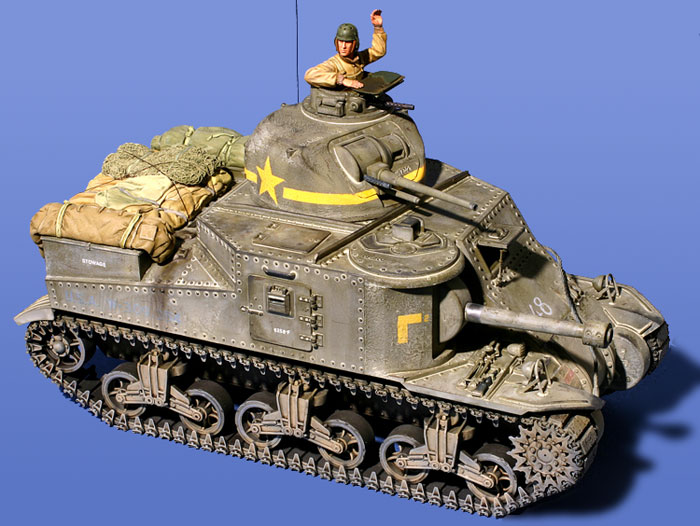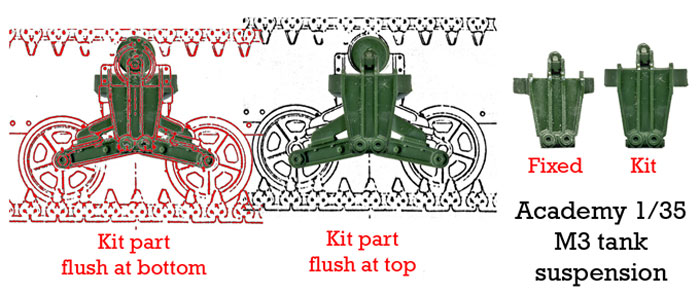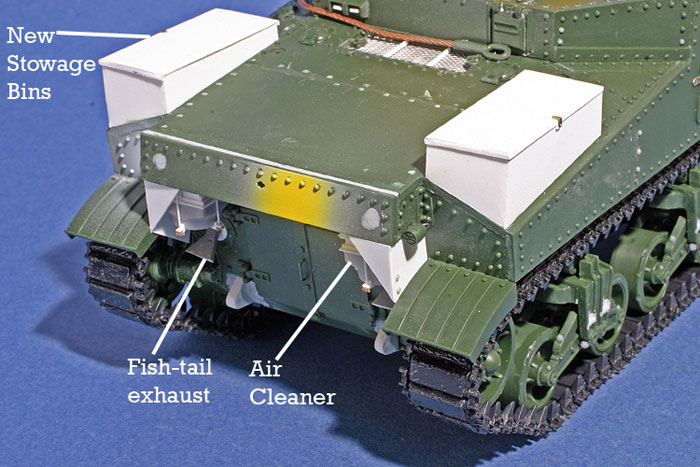|
US Medium
Tank M3 Lee |
Academy, 1/35 scale |

|
| by Steven J. Zaloga |


Academy's
1/35 scale M3 Lee may be ordered online from Mission Models
Description
I recently had the chance to build up one of the new Academy M3 Lee
Medium Tanks courtesy of a kit from Cookie Sewell.
Overall, I would give it a grade
of B-. It will build up into a decent model out of the box, but it
requires a fair number of tweaks to reach current standards of
accuracy. On the positive side, it is significantly better than the
old Tamiya kit, and it includes a rudimentary fighting compartment
interior.

The biggest disappointment is the
inaccurate depiction of the D37893 bogies but there are other
dimensional and shape problems as well which detract from an
otherwise nice kit.
Starting with the bogie issue, the kit provides a new sprue with the
early D37893 (aka M3) bogies plus the existing sprue for the D47527
(aka M4) bogies from the earlier Academy M4A2, M12 and M10 kits. The
new D37893 bogies are significantly too high at 12.5mm when they
should be 10.5mm. While 2mm may not seem much, it is nearly 20% of
the part height. The problem lies entirely in the upper spring
housing and while it can be fixed, it is a tedious, delicate, and
time-consuming process. I will cover this in more detail in an
eventual Military Modeling article, but the accompanying
illustrations show the kit part superimposed on the Ordnance
drawings. The bottom line is that the kit will look okay built
out-of-the-box, but more fastidious modelers will probably want to
deal with the bogies or wait til some after-market improvements
appear.

The other detail that has caught considerable attention on the net
is the odd looking bulge under left side of the turret cupola.
Academy has represented this as a flat rectangular bulge, but this
is too prominent and the wrong shape. This protrusion did exist to
varying degrees on M3 turrets, depending on the foundry. The sides
of the M3 turret are 5 degrees off-vertical except for this wedge
which is 90 degrees. Academy’s depiction runs into trouble as they
make the protrusion flat when in fact it was round and followed the
turret contours. The prominence of this feature varied from foundry
to foundry. It was most prominent on the turrets cast by General
Steel, and less prominent on those cast by ASF and Continental. The
problem is that the markings options in the kit for the 2/13th
Armored Regiment (Kentucky) and 751st Tank Battalion (No. 3) in
Tunisia were Chrysler-built M3 tanks which used the ASF and
Continental turrets. Fortunately, the kit turret is very thick, so
this area can be reshaped with some heavy file work. To further
complicate matters, the cupola bulge was also accompanied by a
trunnion bulge at the 10 o’clock position which is not present on
the kit.
The kit has a significant number of other less-obvious dimensional
problems. The joint between the left front plate and left
superstructure side is set at 53 degrees vs 50, and the front
superstructure side plate to the inside of the 75mm gun is too
vertical. Both of these problems would take significant structural
work to correct, and I didn’t bother as I don’t think they are
particularly apparent. The rear stowage bins are substantially too
small at 10 x 26mm instead of the proper 14 x 30mm (W x L) but
fortunately, this is a fairly straight-forward job with sheet
plastic.

The kit depicts the late 1941 production configuration, but this is
inappropriate for the decal options. So modelers should either
convert their model into the later configuration, or come up with
markings for an earlier vehicle like the Stateside training tanks.
The M3 medium tanks of the 2/13th Armored Regiment like Kentucky on
the decal sheet, and most of those of the 751st Tank Battalion (Tank
3 on the decal sheet) were built by Chrysler in March-April 1942 and
so should have the “quick-fix” exhaust and the later gun options
depending on the tank. The initial production run of M3 tanks had a
pair of cylindrical pepper-pot exhausts under the rear hull overhang
(as provided in the kit), but these created a crew hazard since they
heated up the engine deck plate immediately above. As a result, a
“quick-fix” solution was fielded around January 1942 with the
exhausts being re-routed through a pair of fish-tail exhaust stubs
emanating from the same circular plate as the original exhausts, but
the upper cavities under the hull overhang taken up by the
box-shaped air cleaners so familiar to Sherman modelers. The
ultimate solution was a new pair of stub exhausts under the
overhang, familiar to anyone who has built the Tamiya M4 kit. The
kit only provides the initial exhaust configuration.

While the “quick-fix” exhausts were being introduced on the assembly
line, the armament was being improved with gyro-stabilization which
required the use of a cylindrical counter-weight at the end of the
M2 75mm gun barrel and a tubular counter-weight under the 37mm gun.
The kit does not provide the 75mm M2 counter-weight nor the 37mm
counter-weight.
Model, Images and Text
by Steven J. Zaloga
Page Created 22 May, 2006
Page Last Updated
04 June, 2006
|